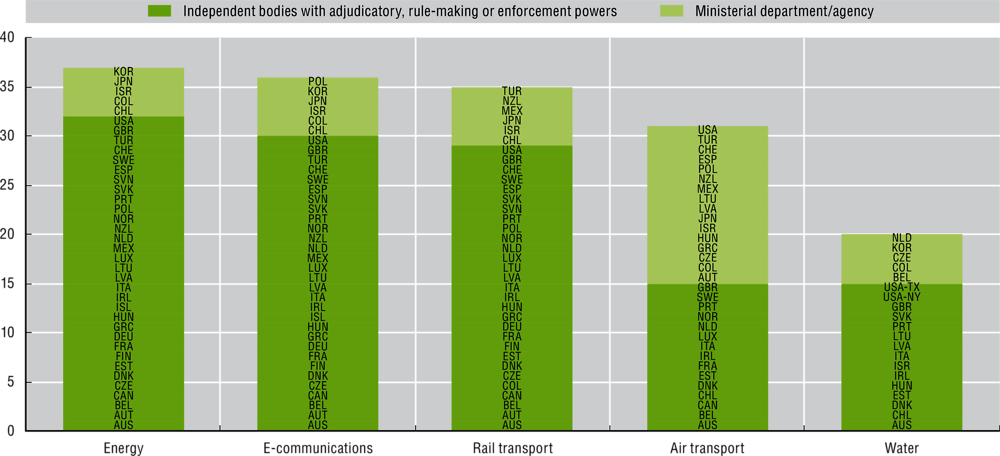The independence of economic regulators
Economic regulators oversee key network sectors that offer critical services. These regulatory authorities play a key role in market functioning and safeguarding the public interest, intervening at the interface between political authorities, businesses and citizens. Many governments choose to grant a degree of independence to economic regulators to limit political influence over their decision making. This independence, when combined with accountability and transparency measures, maintains their credibility and predictability for investors, operators and consumers. Even the perception of bias can hinder regulators’ capacity and credibility as referees mediating between stakeholders and their interests. Robust governance arrangements can safeguard their capacity for technical decision making free from undue influence. Countries can implement a range of such governance arrangements, including establishing legally independent regulators to signal a commitment to long-term goals beyond political cycles.
The OECD Indicators on the Governance of Sector Regulators map the governance arrangements of economic regulators in five network sectors. They show a degree of convergence in the arrangements safeguarding the independence of regulators in OECD countries. This reflects that these regulators have fewer good practice governance arrangements to guarantee their independence, such as rules within which regulators’ leadership is appointed and dismissed , limitations on input into certain decisions and processes, and measures to protect budgetary autonomy (Table 7.8).
Many OECD countries have established legally independent regulators. The OECD recommends that countries consider establishing independent regulators to maintain public confidence, competitive neutrality between public and private enterprises, and impartiality for significant decisions. Among OECD countries, 32 out of 37 regulatory bodies (86%) in the energy sector are independent, as are 30 out of 36 (83%) in the e-communications sector and 29 out of 35 (83%) in the rail sector. In the air transport and water sectors, the share of independent regulators is lower, with 15 out of 31 air transport regulators (48%) and 15 out of 20 water regulators (75%) qualifying as independent bodies. Ministerial regulators that are not at arms length from the government are only in the majority in the air transport sector (Figure 7.9).
The OECD Indicators on the Governance of Sector Regulators form part of the work programme of the OECD Network of Economic Regulators and measure the governance of economic regulators in the energy, e-communications, rail transport, air transport and water sectors. The indicators cover regulators in all OECD countries and in many non-OECD countries. The Secretariat derives the indicators from a questionnaire, distributed alongside the OECD’s Product Market Regulation survey. In general, respondents to the questionnaire were high-level officials in regulatory agencies and/or relevant ministries. The responses go through a rigorous data verification and validation process by the OECD Secretariat, verifying their completeness, consistency and accuracy in consultation with the respondents. The indicators are calculated by averaging equally weighted questions and sub-questions, to avoid imposing judgements about the importance of elements within the composite indicators. They are mapped on a scale from 0 (most effective governance arrangements) to 6 (least effective governance arrangements), in line with the Product Market Regulation methodology. The process of developing the questionnaire, collecting the data, validating the responses and analysing the results benefitted from the extensive support of the OECD Network of Economic Regulators. For a complete description of the methodology see Casullo et al. (2019).
The indicators are divided into three components: independence, accountability and scope of action. This two-pager analyses the independence component which maps the degree to which a regulator operates independently and with no undue influence from political power and regulated sectors.
Further reading
Casullo, L., A. Durand and F. Cavassini (2019), “The 2018 indicators on the Governance of Sector Regulators – Part of the Product Market Regulation (PMR) Survey”, OECD Economics Department Working Papers, No. 1564, OECD Publishing, Paris, https://doi.org/10.1787/a0a28908-en.
OECD (2014), The Governance of Regulators, OECD Best Practice Principles for Regulatory Policy, OECD Publishing, Paris, https://doi.org/10.1787/9789264209015-en.
OECD (2017), Creating a Culture of Independence: Practical Guidance against Undue Influence, The Governance of Regulators, OECD Publishing, Paris, https://doi.org/10.1787/9789264274198-en.
Figure notes
7.8. The composite indicator is calculated as an average of component scores, ranging from 0 (the most effective) to 6 (the least effective) governance arrangements.
Grey cells in the table denote no regulator.
The Spanish National Commission of Markets and Competition (CNMC, with indicator data in the energy, e-communications and rail transport sectors) is subject to approval of different Ministries concerning essential decisions to hire and retain its permanent staff and to design and expend its allotted budget. Budget restrictions apply in particular to human resources and the possibility to hire studies or special assistance services, like research or IT. Likewise, any modification of the organisation of the CNMC requires a legal act adopted by the Government.


